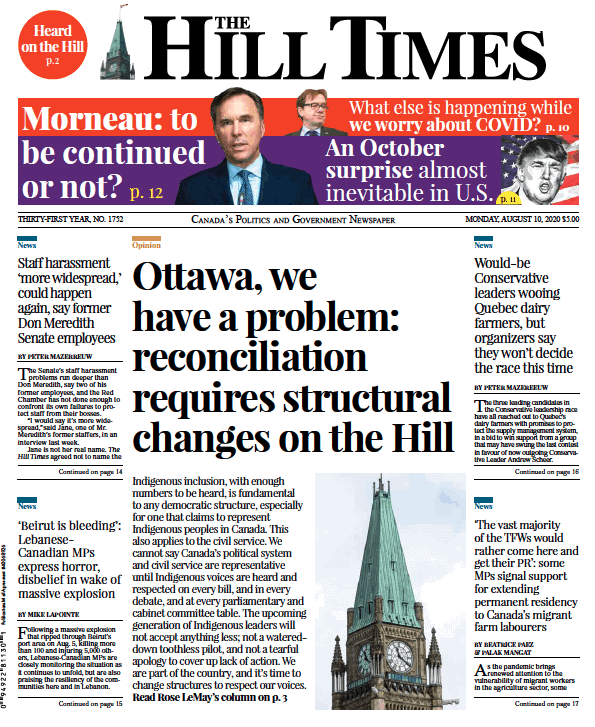Hill Times August 10, 2020

In 2015, the Truth and Reconciliation Commission released the 94 Calls to Action, a roadmap for Canada to find closure on the era of Indian residential schools and to ensure we don’t repeat history. What has changed since 2015 to ensure we don’t repeat history? Dr. Eva Jewell and Ian Mosby recently wrote in the Yellowhead Institute that nine of the 94 calls to action have been completed.
What is holding back real action? Performative action (doing the action for the publicity or doing just enough to avoid negative publicity), and the lack of structural accountability for change. Quite simply, nobody is holding the country to account.
This is the first in a series of columns presenting different approaches to structure reconciliation, based on international and wise practices.
Let’s start with political structures. Ottawa, we have a problem.
There are nine Indigenous MPs in federal office and about 24 in provincial/ territorial offices. In its history, Ontario has only elected five Indigenous politicians. Alberta and Quebec do not currently have any Indigenous representation, and Nova Scotia and Prince Edward Island have never elected an Indigenous politician. A total of about 33 seems like a good number but they are spread out across the country, and even on the Hill they are spread out across
committees. Sol Mamakwa from Kingfisher Lake First Nation shared in Maclean’s last week that “as a First Nations MPP in Ontario … I cannot deny my loneliness.”
Here are some ideas to fix the problem: we bring in Indigenous candidate proportion requirements; a model of Indigenous representational governance; and an Indigenous Senate.
Political parties at the federal and provincial/ territorial level could be required by law to field a certain percentage of Indigenous candidates and, no, it won’t
lower standards, and, yes, there will be Indigenous people who are interested. We need more Indigenous candidates to push the conversation to be inclusive at the local party level. More Indigenous candidates leads to more Indigenous politicians. We need more Indigenous politicians to push the conversation to be more inclusive in every single debate and in every hallway conversation on the Hill. One Indigenous voice in committee is too easily ignored, but three or four Indigenous voices cannot be ignored.
Imagine if there were 40 Indigenous MPs invested in Bill C-3, the legislation to strengthen civilian review of the RCMP and Canada Border Agency? It’s safe to say that Indigenous people would be legally required to be part of any civilian oversight structure.
How about the debates regarding the COVID-19 vaccine trials? If we had 40 Indigenous MPs, then perhaps questions would have been asked why the COVID-19 Vaccine Task Force includes no Indigenous voice (or any people of colour apparently), and demand that any vaccine trial includes Indigenous people?
Changing the discourse on the Hill is both about numbers and structure. To increase the number of Indigenous politicians, we have to change the structure through law and policy: we need a law requiring parties to field Indigenous candidates and we need policies to give excellent support to those candidates. It obviously won’t happen without such changes to structure, the past five years have conclusively proven this.
Indigenous inclusion with enough numbers to be heard is fundamental to any democratic structure, especially for one that claims to represent Indigenous
peoples in Canada. This also applies to the civil service. We cannot say Canada’s political system and civil service (including parties, task forces, committees and all resulting products) are representative until Indigenous voices are heard and respected on every bill and in every debate and at every parliamentary committee table. The upcoming generation of Indigenous leaders will not accept anything less, not a watered down toothless pilot, and not a tearful apology to cover up lack of action. We are part of this country, and it’s time to change structures to respect our voices.
Stay tuned for my next columns on the Norway model for Sami, inclusion similar to an Indigenous Senate, New Zealand’s Maori Party, and an idea based the EU model.
